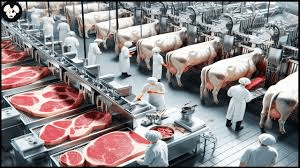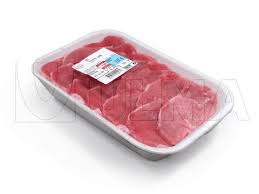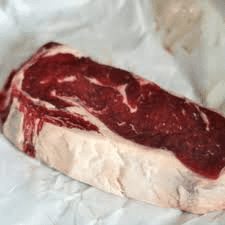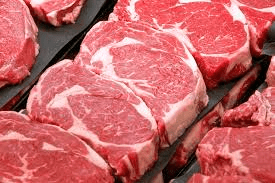Processing, packaging, and exporting beef meat involves several crucial steps to ensure the meat reaches consumers in top condition. The journey begins with the raising and care of cattle. Proper care, feeding, and health monitoring are essential to ensure high-quality beef. When the cattle reach the appropriate age and weight, they are transported to a slaughterhouse.
At the slaughterhouse, the cattle are humanely slaughtered following strict regulations to ensure animal welfare and meat quality. The first step after slaughtering is bleeding, which is done quickly to maintain meat quality. The carcass is then skinned, and the internal organs are removed in a process called evisceration. This is done carefully to prevent contamination.
Once the carcass is cleaned, it is divided into halves and then quarters. These quarters are inspected by veterinarians and food safety experts to ensure they meet health and safety standards. Any carcass that does not meet these standards is discarded. The inspected meat is then chilled to reduce its temperature quickly, preventing bacterial growth and maintaining freshness. The chilling process can take up to 24 hours.
After chilling, the beef quarters are broken down into various cuts of meat. This is done by skilled butchers who separate the meat based on quality and type. Different cuts include steaks, roasts, ribs, and ground beef. Each cut is trimmed to remove excess fat and bones, ensuring only the best parts are used.
The next step is packaging. Proper packaging is vital to protect the meat during transportation and to maintain its quality and freshness. The meat is vacuum-packed or placed in airtight containers to prevent exposure to air, which can cause spoilage. The packaging is labeled with important information, including the type of cut, weight, expiration date, and any relevant handling instructions. This ensures that consumers have all the necessary information about the product.
Exporting beef meat involves several logistical and regulatory considerations. Exporters must comply with international standards and regulations related to quality, safety, and labeling. This includes obtaining necessary certifications and ensuring that the beef meets the import requirements of the destination country. Proper documentation is crucial and typically includes health certificates, certificates of origin, and other relevant paperwork.
Transportation is a key aspect of exporting beef meat. The packaged meat must be handled carefully to prevent damage and spoilage. Beef is usually transported in refrigerated containers, known as reefer containers, which maintain a controlled temperature throughout the journey. This is essential to keep the meat fresh and safe for consumption. During transport, it is important to monitor the temperature and humidity levels to ensure optimal conditions.
Once the beef meat reaches its destination, it goes through customs clearance, where the documentation and quality of the meat are inspected. If everything is in order, the meat is cleared for entry into the market. It is then distributed to wholesalers, retailers, or directly to consumers, depending on the supply chain setup.
In summary, processing, packaging, and exporting beef meat involves a series of well-defined steps that ensure the meat retains its quality from the farm to the international market. Starting with the humane slaughtering of cattle and careful processing of the meat, through chilling, cutting, and packaging, each step is crucial for producing high-quality beef. Proper packaging and compliance with export regulations further ensure that the beef reaches its destination in excellent condition. By following best practices throughout the process, producers and exporters can provide a valuable product that meets global standards and satisfies customers around the world.
By maintaining strict hygiene standards and following best practices, producers can ensure the beef meat is safe and of high quality. Regular inspections and quality checks at every stage of the process help in maintaining these standards. As the global demand for beef continues to grow, following these steps carefully will ensure that the meat meets the expectations of consumers and adheres to international regulations. This meticulous approach to processing, packaging, and exporting beef meat helps build trust with consumers and maintains the reputation of producers and exporters in the global market.
How to Process Beef Meat for Exportation

1. Animal Selection: Choose healthy animals for slaughter. Conduct a thorough health check to ensure they are free from diseases. This step ensures high-quality meat and complies with health regulations.
2. Slaughtering: Transport the selected animals to a certified slaughterhouse. Follow humane slaughtering practices to reduce stress on the animals and ensure meat quality. This step should comply with local and international standards.
3. Bleeding: After slaughtering, hang the carcass to allow thorough bleeding. Proper bleeding is crucial to improve meat quality and shelf life. This step involves cutting the major blood vessels in the neck.
4. Evisceration: Remove the internal organs from the carcass. This process should be done carefully to avoid contamination. The organs should be inspected and disposed of or processed as per regulations.
5. Carcass Splitting: Split the carcass into halves or quarters for easier handling. This step is typically done using a saw. Proper splitting helps in further processing and packaging.
6. Chilling: Chill the carcass at a temperature of 0-4°C to prevent bacterial growth. Rapid chilling is essential to maintain meat quality and extend shelf life. This step should be done immediately after slaughtering.
7. Deboning: Remove bones from the chilled carcass. This step requires skilled labor to ensure maximum meat yield and minimal waste. Deboned meat is easier to package and transport.
8. Trimming: Trim excess fat and unwanted parts from the meat. Proper trimming enhances the appearance and quality of the meat. This step should be done carefully to retain maximum meat.
9. Cutting: Cut the meat into desired portions or products as per market requirements. This can include steaks, roasts, ground beef, etc. Use sharp knives or meat saws for precise cuts.
10. Quality Control: Inspect the meat for quality and compliance with export standards. This includes checking for proper color, texture, and absence of contaminants. Quality control ensures that the meat meets customer expectations.
11. Packaging: Pack the processed meat in suitable materials to maintain freshness. This can include vacuum-sealing or using modified atmosphere packaging. Proper packaging prevents contamination and extends shelf life.
12. Labeling: Label each package with essential information such as product name, weight, origin, and processing date. Include any specific details required by the importing country, such as certification marks or handling instructions.
13. Freezing: Freeze the packaged meat at -18°C or lower to preserve quality. Rapid freezing prevents ice crystal formation, which can damage meat texture. Ensure consistent freezing to maintain product quality.
14. Storage: Store the frozen meat in a clean, temperature-controlled environment. Proper storage prevents spoilage and maintains meat quality. Ensure regular temperature monitoring to prevent any issues.
15. Documentation: Prepare all necessary export documentation, including health certificates, certificates of origin, and compliance with international standards. Accurate documentation is crucial for smooth customs clearance.
Read Also: Chiggers: Description, Damages Caused, Control and Preventive Measures
How to Package Beef Meat for Exportation

1. Select Packaging Materials: Choose strong and protective packaging materials such as vacuum-sealed bags, plastic trays with film, or boxes with liners. These materials should protect the meat from contamination and freezer burn.
2. Determine Packaging Size: Decide on the size and weight of the packages based on customer requirements and shipping logistics. Common sizes include individual cuts, bulk packs, or portion-controlled packs.
3. Vacuum Sealing: Vacuum-seal individual cuts or portions to remove air and extend shelf life. This method prevents freezer burn and maintains meat quality. Use high-quality vacuum-sealing equipment for best results.
4. Modified Atmosphere Packaging (MAP): For certain products, use MAP to extend shelf life. This involves replacing the air inside the package with a gas mixture to slow down spoilage. This method is particularly useful for fresh meat.
5. Label Packages: Clearly label each package with essential information such as product name, weight, origin, processing date, and expiration date. Include any specific details required by the importing country, such as certification marks or handling instructions.
6. Include Documentation: Attach necessary export documents such as health certificates, certificates of origin, and packing lists to each package or keep them readily available for customs inspection.
7. Use Cushioning: For delicate or high-value meat products, use cushioning materials like bubble wrap or foam inserts to provide extra protection. This helps prevent any damage during handling and transport.
8. Palletize: Arrange the packages on pallets for bulk shipments. Secure the packages with straps or shrink wrap to prevent them from shifting during transit. Palletizing improves handling efficiency and protection.
9. Inspect Packaging: Check that all packages are properly sealed, labeled, and free from defects. Ensure there are no damaged or compromised packages to avoid issues during shipping and customs clearance.
10. Cold Storage: Store packaged meat in a temperature-controlled environment until it is ready for shipment. Maintain a consistent temperature to prevent spoilage and ensure the meat remains frozen.
How to Export Beef Meat for Profits
1. Conduct Market Research: Research potential markets and identify countries with high demand for beef meat. Understand market trends, prices, and competition to position your product effectively.
2. Understand Export Regulations: Familiarize yourself with export regulations and requirements for the target market. This includes tariffs, import restrictions, and quality standards specific to beef meat.
3. Find Reliable Buyers: Reach out to potential buyers, importers, or distributors in your target market. Attend trade shows, join industry associations, and use online platforms to connect with buyers interested in beef meat.
4. Set Competitive Pricing: Determine a competitive pricing strategy based on production costs, market demand, and profit margins. Consider factors such as quality, packaging, and volume discounts when setting prices.
5. Negotiate Terms and Conditions: Negotiate terms with buyers including payment terms, delivery schedules, and contract conditions. Ensure that both parties agree on these terms before finalizing the export deal.
6. Arrange Logistics: Coordinate logistics and transportation to ensure timely and safe delivery of beef meat. Choose reliable logistics providers who specialize in handling perishable goods.
7. Monitor Quality: Implement quality control measures to ensure the meat meets export standards. Regularly inspect the products during processing and packaging to address any issues before shipment.
8. Prepare Documentation: Complete all required export documentation accurately and in compliance with international trade regulations. This includes invoices, packing lists, health certificates, and other necessary documents.
9. Promote Your Product: Invest in marketing and promotional activities to increase visibility and attract more buyers. Use online marketing, social media, and trade publications to reach a broader audience.
10. Evaluate and Adjust: Regularly review your export performance and customer feedback. Make adjustments to your strategy as needed to improve profitability and expand your market reach.
Read Also: How To Grow, Use and Care For Threespike Goosegrass (Eleusine Tristachya)
Frequently Asked Questions (FAQ’s) About Beef Meat

1. What is the best cut of beef for export? The best cuts for export include ribeye, tenderloin, sirloin, and brisket. These cuts are popular for their tenderness and flavor.
2. How should beef be stored before export? Beef should be stored in a clean, temperature-controlled environment, ideally frozen at -18°C or lower to preserve quality and prevent spoilage.
3. What are the main export markets for beef? Major export markets for beef include the United States, China, Japan, South Korea, and the European Union. These regions have high demand for quality beef products.
4. How is beef inspected for export? Beef is inspected for export through government-regulated programs that ensure the meat meets health and safety standards. This includes checking for diseases, contaminants, and proper handling practices.
5. What documentation is required for exporting beef? Necessary documentation includes health certificates, certificates of origin, export licenses, and compliance with international standards. Accurate documentation ensures smooth customs clearance.
6. How does vacuum sealing benefit beef export? Vacuum sealing removes air from the package, extending shelf life and preventing freezer burn. This method maintains the quality and freshness of the meat during transit.
7. What are the challenges in exporting beef? Challenges include meeting stringent import regulations, maintaining cold chain logistics, and managing tariffs and trade barriers. Addressing these challenges is crucial for successful exportation.
8. How can exporters find reliable buyers for beef? Exporters can find buyers by attending trade shows, joining industry associations, using online platforms, and building relationships with importers and distributors in target markets.
9. What is the role of quality control in beef export? Quality control ensures that the beef meets export standards and customer expectations. It involves regular inspections during processing, packaging, and storage to maintain high quality.
10. How can exporters promote their beef products? Exporters can promote their products through online marketing, social media, trade publications, and participating in food fairs and exhibitions. Effective promotion helps attract more buyers and expand market reach.
Read Also: Potato Farming Guide – 7 Tips to Grow Sacks Full of Potatoes






